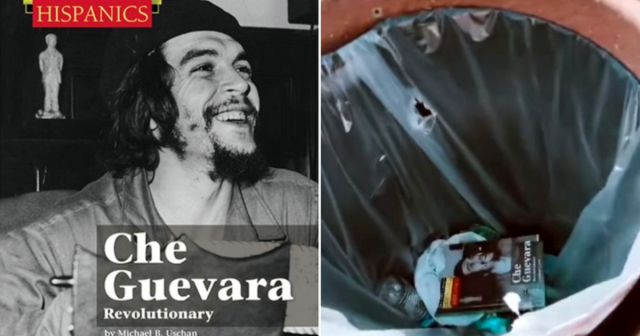
Ernesto Che Guevara coordinated with Sorí Marín the drafting of the Agrarian Reform Law, signed on May 17, 1959 by Fidel Castro. He did it from a luxurious house in Tarará where he settled in 1959. This is how Aleida March, the Argentine's ex-wife, tells it in her book Evocation, of which the portal Cubadebate has published some fragments.
The Agrarian Reform Law confiscated all agricultural properties in Cuba of more than 400 hectares in area.
Fidel Castro attended the meetings held on Agrarian Reform almost daily in the house that Che occupied in Tarará because at that time he lived in Cojímar, says Aleida March.
Known as "the Tarará Group", those meetings became a kind of government parallel to that of Manuel Urrutia.
in his book Evocation, Aleida March recounts the comforts she enjoyed with Che after he was diagnosed with the first symptoms of pulmonary emphysema, in January 1959. According to her story, in order for him to recover, they went to live for two months in a house, in top of a hill in Tarará. The home had belonged to a Customs inspector.
By then Fidel Castro had named Che commander of the La Cabaña fortress, where an unknown number of shootings were carried out without legal guarantees.
"The famous Tarará house was a comfortable house that allowed Che to carry out his offices from his room. Not being able to travel daily to La Cabaña, he could remain lying down all the time and it allowed me to move freely," says Aleida. March in his book.
"There was a different air that was more elegant and comfortable than there (in La Cabaña), as the house was surrounded by large windows with opaque glass and had a lot of ventilation, because it was located on a small hill."
"On the ground floor, among other details, it had a small office, secluded and located at the end. On the upper floors, in the large room occupied by Che, there was furniture with careful lines, a small striped sofa and a very large dressing room. Next door was a large marble-veneered bathroom, attached to a walk-in closet. Then came another room, which was my room, because since we were not officially married, due to my delays and taboos, we pretended to sleep separately. , and along its entire length, there was a large room where the escort stayed, and a small pantry."
Che's stay in the luxurious house in Tarará did not go unnoticed and was reported in the press by journalist Antonio Llano Montes, in an article published in Posters, in the section After the news, titled "Commander Guevara established his residence in Tarará."
Offended by the publicity of his bourgeois tastes, Che Guevara wrote a letter to the newspaper Revolution on March 10, 1959. In the letter, addressed to the director of the newspaper, Carlos Franqui, he stated that he was concerned with the insinuations of journalist Llano Montes about "his revolutionary stance" because he considered that the news about his residence in Tarará was " an insult to popular sensibilities."
"I clarify to the readers of Revolution "that I am sick, that I did not contract my illness in gambling dens or staying up late in cabarets, but rather by working more than my body could withstand for the Revolution," Che wrote.
Furthermore, he justifies his installation in one of the luxury developments on the eastern beaches of Havana by appealing to his modest salary of only 125 Cuban pesos.
"The doctors recommended a house in a place away from the daily visits and Asset Recovery lent me this one that I will live on the aforementioned beach until the colleagues who care for me discharge me; I had to occupy a house belonging to representatives of the old regime because "My salary of $125.00 as an officer in the Rebel Army does not allow me to rent one large enough to house the people who accompany me."
Che acknowledges that the house chosen to rest was "luxurious", but clarifies that he chose the simplest one in the place.
The house occupied by Che Guevara was on 14th street, corner 17According to Eduardo Porretti, Argentine ambassador to Venezuela, on his blog. The diplomat describes the house as "a kind of two-story Californian chalet, with a gable roof and a balcony." It is, as described, the largest in the area where it is located.
The Tarará tourist complex was built around 1943 with US capital from three Americans who founded the public limited company The Tarará land Company. Its first 525 houses, in the Art Deco style, were surrounded by restaurants, sports centers, the church of Santa Elena, patron saint of the town that went out in a procession every August 15, and the pier next to the mouth of the Tarará River to the sea. According to Hemingway, this was the safest port in all of Cuba.
Aleida March herself acknowledges that the house she occupied in Tarará with Che Guevara was more luxurious than the one assigned to her in La Cabaña and that it had been built in the mid-19th century. During the Government of Fulgencio Batista it was inhabited by the commander of La Cabaña, Lieutenant Colonel Fernández Miranda.
From that house in La Cabaña, Aleida March not only began to wear the clothes of Lieutenant Colonel Fernández Miranda's wife, but also kept the family dog, which was abandoned by the family when she hurriedly fled Cuba. The animal died of old age in the home of four of Che's children.
That house in La Cabaña today is a museum.
Tarará, for its part, has been recovered as a marina by the Ministry of Tourism for mooring yachts for foreign visitors. The urbanization was destroyed after serving for years, since 1975, to host stays for Cuban pioneers and then, starting in 1990, for Russian children sick after the Chernobyl accident.
Between 1959 and 1975 it also hosted the Antón Makarenko training school, where Cuban peasant women received cutting and sewing classes.
What do you think?
COMMENTFiled in:






